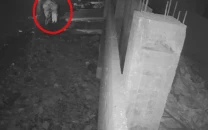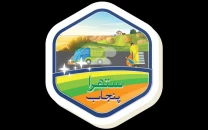Saving the environment: Last gasp for 2-stroke polluters
Rawalpindi city administration’s fresh drive may yield results.

Rawalpindi city administration’s fresh drive may yield results.
The Rawalpindi district government has launched the campaign to do away with the two-stroke variety three-wheelers -- popular in the congested parts of the inner city -- to switch to a better engine.
“The four-stroke engine is more environment-friendly than the two-stroke variation,” Awais Tarrar, Secretary District Rawalpindi Transport Authority (DRTA), said.
According to a study of the Pakistan-Environment Protection Agency (Pak-EPA), the 2-stroke rickshaw emits two times more carbon dioxide (CO) and 37 times more hydrocarbons than a 4-stroke rickshaw.
However, this is not the first time that a campaign to ban the 2-stroke rickshaws has been launched in a major city, the Punjab government has been struggling to phase out the 2-stroke rickshaws since 2005, after the Lahore High Court (LHC) ordered for introducing 4-stroke rickshaws by the end of 2007.
Since then, the government’s policy hinged on loan schemes for rickshaw drivers to buy new, subsidized 4-stroke rickshaws. However, according to a 2009 report of the Centre for Public Policy and Governance (CPPG) on the Punjab government’s rickshaw policy, high maintenance costs, expensive spare parts and lack of trained mechanics for 4-stroke rickshaws led rickshaw drivers to default on the loans.
The above factors resulted in the decline of demands for the 4-stroke rickshaws, and almost six years after the court’s deadline expired, the 2-stroke rickshaws still ply the roads of Rawalpindi.
There were 4,000 2-stroke engine rickshaws in Rawalpindi in 2007 when the DRTA stopped issuing and renewing their permits. (The count has not been updated since.). Tarrar said that some of the rickshaws have been phased out to smaller cities and towns.
Tarrar said that since the when the campaign has been resuscitated, the DRTA has converted over four dozen 2-stroke rickshaws into 4-stroke engines between February 11 and 17, with 200 challans to violators.
“I’ve been driving a rickshaw since Zulfiqar Ali Bhutto’s time,” Younas, a rickshaw driver outside the Arid Agriculture University in Rawalpindi, said. “There is no way the 2-stroke rickshaw is going away.”
Younas thinks the 4-stroke-rickshaw is a ‘failure’. His opinion is based on the associated costs of the 4-stroke rickshaw.
The new rickshaws first appeared in Rawalpindi around 2006 and today, there are around 3,100 Compressed Natural Gas (CNG) 4-stroke rickshaws registered with the DRTA.
Umar Farooq, a rickshaw driver, who recently bought a new 4-stroke rickshaw, said, “This rickshaw is more spacious than the old 2-stroke.” “People prefer travelling in it.”
In return, Farooq charges the passengers Rs20-30 more than the regular fare. But he paid Rs195,000 to buy the rickshaw, which is steep because 2-stroke rickshaws can be bought for less than Rs10,000.
Conversion from 2-stroke to 4-stroke costs around Rs30,000, the rickshaw drivers said. The cost includes the engine and changes to the body of the rickshaw. Installing a CNG kit incurs at least additional Rs20,000.
On top of that, 4-stroke engine’s spare parts are imported and therefore expensive.
“The 4-stroke gear box costs around Rs2,500,” Ameer Khan, who runs a rickshaw repair and spare parts shop in Chah Sultan in Rawalpindi, said. Comparable repairs for a 2-stroke engine can be done with individual nuts and bolts which never exceed the Rs100-200 range, Khan said.
Younas said there are no trained mechanics of the 4-stroke engine available, which means the rickshaw might be out of commission if the mechanics cannot figure out the fault.
And so on the roads of Rawalpindi, the air pollution debate loses its feet quickly and is replaced by more pressing needs: livelihood and poverty. Any mention of emissions or smog is met with incredulous shakes of the head followed by the occasional “no one dies of pollution” rants.
Meanwhile, the conversion campaign goes on without taking the stakeholders such as rickshaw drivers into confidence.
Tarrar admitted the conversion is hard for the rickshaw owners.
“We are giving the rickshaw owners seven to 10 days to convert the rickshaws because it is not an inexpensive procedure,” Tarrar said.
He hopes the whole campaign will be completed in a month time.
SIDE BAR:
Rickshaw crackdown process: The DRTA officials impound 2-stroke rickshaws and issue challans to the drivers. When the owners come to recover the impounded vehicles, they are asked to affirm on a stamp paper that they will get their rickshaws converted to the eco-friendly engine. The rickshaws are handed over to the owners but the original documents of the rickshaw are confiscated and only returned if the owners return with proof that the rickshaw has been converted.
2-stroke and 4-stroke difference: The 2-stroke engine does not have a lubricating mechanism, so lubricating oil is mixed with fuel. During the combustion cycle in the engine, some of the unburned fuel and significant amount of oil escape through the exhaust as soot or thick black smoke. The 4-stroke engine is better because it has a separate lubricating system and because it burns the fuel thoroughly.
Rickshaw crackdown process
The DRTA officials impound the rickshaws and issue a challan to the drivers. When the owners come to recover the impounded vehicles, they are asked to affirm on stamp paper that they will get their rickshaws converted to the eco-friendly engine. The rickshaws are handed over to the owners but the original documents of the rickshaw are confiscated and only returned if the owners return with proof that the rickshaw has been converted.
2-stroke and 4-stroke difference
The 2-stroke engine does not have a lubricating mechanism, so lubricating oil is mixed with fuel. During the combustion cycle in the engine, some of the unburned fuel and significant amount of oil escape through the exhaust as soot or thick black smoke. The 4-stroke engine is better because it has a separate lubricating system and because it burns the fuel thoroughly.
Published in The Express Tribune, February 24th, 2013.



















COMMENTS
Comments are moderated and generally will be posted if they are on-topic and not abusive.
For more information, please see our Comments FAQ